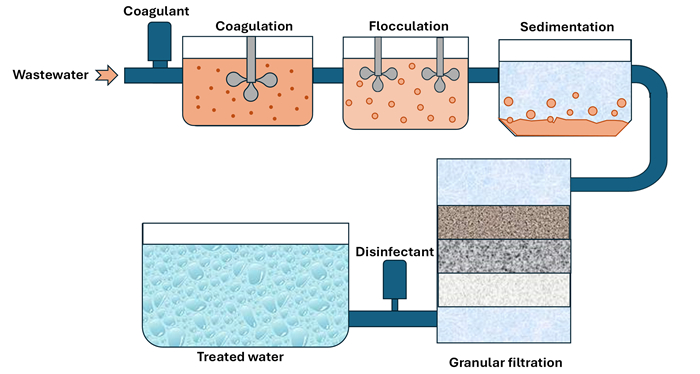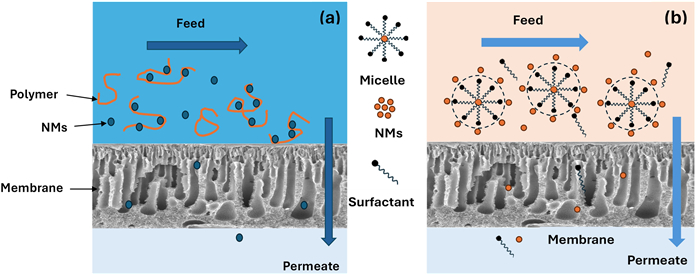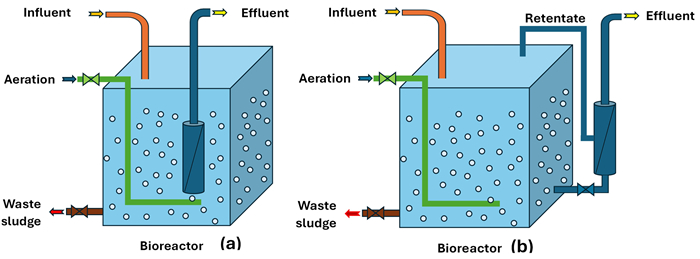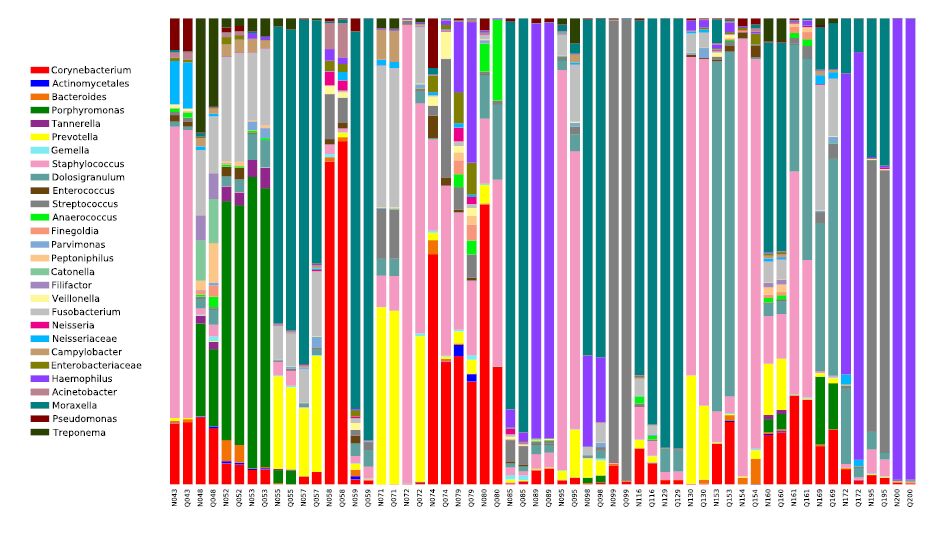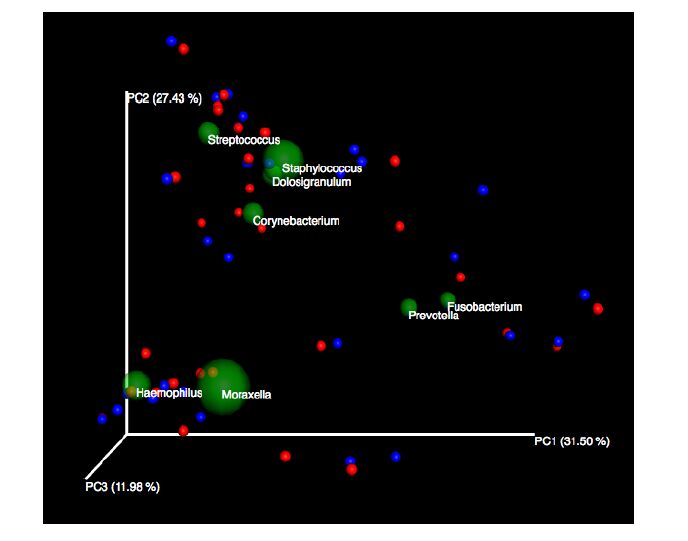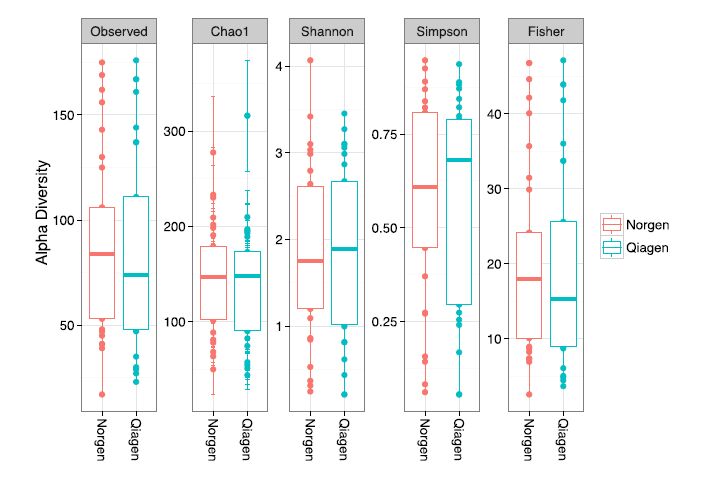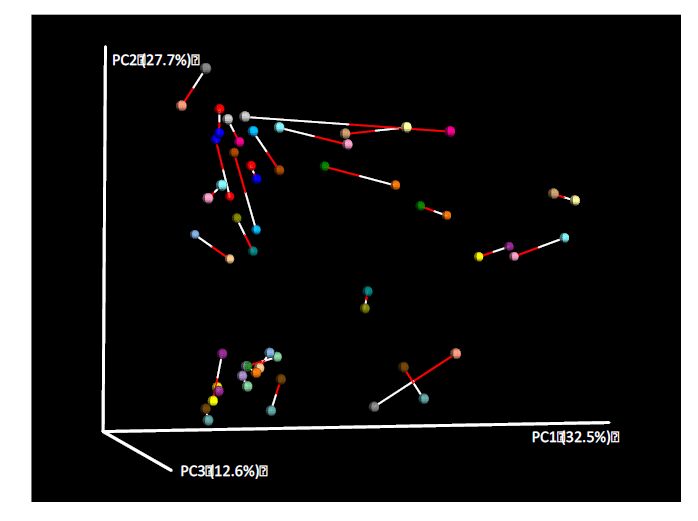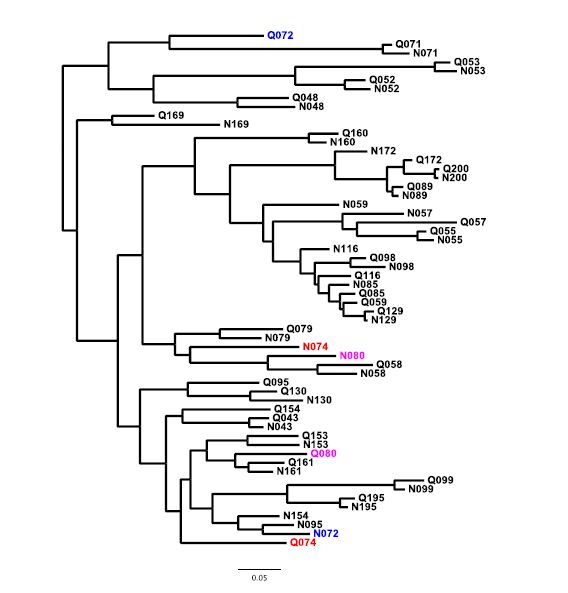Characterization of microbial communities via next-generation sequencing (NGS) requires an extraction ofmicrobial DNA. Methodological differences in DNA extraction protocols may bias results and complicate inter-study comparisons. Here we compare the effect of two commonly used commercial kits (Norgen and Qiagen)for the extraction of total DNA on estimatingnasopharyngeal microbiome diversity. The nasopharynxis a reservoir for pathogens associated with respiratory illnesses and a key player in understandingairway microbial dynamics.
Total DNA from nasal washes corresponding to 30 asthmatic children was extracted using theQiagenQIAamp DNA and NorgenRNA/DNA Purification kits and analyzed via IlluminaMiSeq16S rRNA V4 ampliconsequencing. The Norgen samples included more sequence reads and OTUs per sample than the Qiagen samples, but OTU counts per sample varied proportionallybetween groups (r = 0.732).Microbial profiles varied slightly between sample pairs, but alpha- and beta-diversity indices (PCoAand clustering) showed highsimilarity between Norgen and Qiagenmicrobiomes. Moreover, no significant differences in community structure (PERMANOVA and adonis tests) and taxa proportions (Kruskal-Wallis test) were observed betweenkits. Finally, aProcrustes analysis also showed low dissimilarity (M2 = 0.173; P< 0.001) between the PCoAs of the two DNA extraction kits.
Contrary to what has been observed in previous studies comparing DNA extraction methods, our 16S NGS analysis of nasopharyngeal washes did not reveal significant differences in community composition or structure between kits. Our findingssuggest congruence between column-based chromatography kits and supportthe comparison of microbiomeprofilesacross nasopharyngeal metataxonomic studies.
1.
Introduction
The production of nanomaterials (NMs) has increased in the last years due to their demand in daily life products and industrial applications. The global NM market was worth about US$10.3 billion in 2020. It is anticipated that the market growth will increase to US$38.2 billion by 2029, and the compound annual growth rate (CAGR) is estimated at approximately 18% [1]. Dhall et al. [2] estimated that 55 tons of silver, aluminium oxides, iron oxides, and cerium oxides are produced per year. They further reported that silicon dioxide accounts for 5500 tons, while titanium dioxide and zinc oxide account for 3000 and 550 tons, respectively. The growth of the NM market is fostered by the ongoing research into developing new and advanced materials. NMs mostly exist in the nanoscale range of 1 to 100 nanometres (nm), which means they are characterised by a significantly high surface area-to-volume ratio. This has intensively increased research which is uncovering the novel applications of NMs. They have unique physical, chemical, and biological characteristics which have driven a large amount of research in diverse applications such as healthcare, engineering, energy, and environmental remediation.
The expansion in the applications of NMs also come with repercussions on the economy, as well as the environment and biotic life. NMs are enhancing economic growth through innovation, the creation of new markets and jobs, and improving manufacturing processes, production, and product performance. They have provided solutions to global challenges in healthcare, water, engineering, energy, and environmental sustainability [3,4]. While offering potential economic benefits, NMs have adversely affected economic development. NMs are also impacting the economy through environmental and health concerns triggered by unique properties of NMs and unintended consequences.
There are various types of NMs, and these are naturally occurring NMs, intentionally synthesised NMs, and unintentional NMs, which are generated by industrial processes and natural phenomena. Studies have been carried out to investigate NMs' life cycle, including the analysis of how they can enter the environment and cause adverse effects [5,6]. NMs find their way into the environment directly during their synthesis or indirectly through industrial effluents, chimney emissions, and natural emissions. Their intentional or unintentional release poses environmental risks, including pollution of water, air, and soil, and accumulation in ecosystems [7]. Furthermore, NMs cause potential harm to living organisms including plants and humans. NM contamination in plants can negatively affect nutrient uptake, photosynthesis, and overall metabolic processes, which may lead to stunted growth, chlorosis, and reduced biomass [8]. Exposure of humans to NMs can cause various diseases such as cancer, cardiovascular disease, neurological disorders, liver damage, and kidney failure [9]. Therefore, due to their effects on the environment and humans, NMs are considered to be emerging pollutants or nanocontaminants [7].
NMs eventually enter industrial and municipal wastewater, and several techniques including conventional treatment methods, such as membrane filtration (ultrafiltration, nanofiltration, reverse osmosis), membrane distillation, and adsorption, and advanced oxidation processes have been employed to remove NMs [10,11]. Conventional treatment methods were not designed to remove NMs from wastewater. This has resulted in the improvement of these conventional treatments and the development of new techniques which can effectively remove NMs from wastewater. Conventional filtration is one of the traditional techniques used in wastewater treatment [12]. It is a combination of processes which play different roles in the removal of micro- and nanopollutants. The processes of conventional filtration include coagulation, flocculation, sedimentation, and filtration. Coagulation and flocculation enable the removal of NMs through aggregation, thus making them bigger and denser [13]. The filtration process in conventional filtration is usually granular filtration which used granules to trap NMs during the filtration process.
Membrane techniques have been developed to remove pollutants ranging from micro- to nano-size [14]. These membranes differ in their application due to their pore sizes and configurations. Nanofiltation (NF) and reverse osmosis (RO) membranes, which are pressure-driven, have the ability to effectively remove NMs. Therefore, NF and RO membranes have found applications in the removal of NMs from municipal and industrial wastewater [15,16]. Membranes have also been combined with other process such as bioreactors to effectively remove micro- and nano-contaminants [17]. Membranes are now incorporated into conventional filtration processes due to their excellent retention properties.
This review discusses the most relevant information on NMs' production, sources, environmental and human effects, and deposition into municipal and industrial wastewater. It also discusses the removal of these NMs from the wastewater using conventional filtration and membrane techniques.
2.
Nanomaterials
Developments in nanotechnology has seen diverse NMs being extensively applied in research, industry, and medical fields due to their unique nanoscale-induced physicochemical properties. NMs are a class of chemical compounds, elemental metals, and engineered materials containing at least one structural dimension at the nanoscale range (1 × 10–9 to 100 × 10–9 m) [18,19]. They have a high specific surface area and a potential difference in their behaviour as compared with their bulk counterparts; hence, their application in different industries has brought enormous benefits to humankind. However, the impact of these nanomaterials on human health and the environment is still being explored, and hence they are considered as emerging environmental contaminants [20,21].
2.1. Classification of NMs
NMs exist in different types, shapes, and sizes. Their classification can therefore be based on several considerations. They can be organic or inorganic or hybrid (organic and inorganic) in nature [22], and can be classified according to their origin, construction, and dimensionality, as displayed in Table 1.
2.1.1. Classification based on origin
The origin of NMs can be natural [24], incidental [25], or from manufacturing/anthropogenic processes [26]. The naturally occurring NMs include black carbon, fullerenes, and carbon nanotubes, which have been existing in the environment at low concentrations. They can be from various natural activities such as volcanic activities, forest fires, soil erosion, weathering, clay minerals, and dust storms. Incidental nanomaterials are side products generated by mechanical actions or anthropogenic processes [27,28], whereas anthropogenic nanomaterials are produced deliberately with specific properties [26,29]. Examples of NMs from anthropogenic activities include burning fossil fuels, mining/demolition, automobile traffic, production of NMs, and the waste stream [30].
Nature has created inorganic and organic nanomaterials in the forms of nanotubes, nanodots, and nanowires [31], for example, nanoscopic ash or soot particles as a result of volcanic activity, fires, or other types of combustion [32]. Volcanic eruptions, desert surfaces, and dust from cosmic sources, among others, are considered to be major natural sources of NMs in the atmosphere. The ashes that are released during volcanic eruptions can have chemical interactions with the environment, which result in the deposition of a wide range of NMs [33]. Volcanic ash clouds contain a wide variety of polydisperse nanoparticles which are chemically primarily composed of silicate and iron compounds. Fire can produce inorganic spheres which eventually may result in NMs due to precipitation, oxidation, and, to a lesser extent, reduction [32]. The incomplete burning of fossil fuels can also produce NMs in the form of soot or black carbon. Fullerene NMs can also result from the combustion of organic matter such as coal-burning power plants, petrol, diesel, and fuel gas soot. They are environmentally stable and can coexist with biological life at low concentrations [22]. Carbon nanotubes (CNTs) and clay nanotubes are also naturally occurring NMs. Halloysite is an example of clay nanotubes. It is an aluminosilicate clay that forms due to weathering of volcanic feldspars. Water can contain some polydisperse NMs based on calcium carbonate and calcium sulfate, which are often laced with other elements, such as iron oxides [32]. Other naturally occurring NMs can result in chemical weathering processes of silicates, oxides, and other minerals. Acid mine drainage (AMD) is another source of NMs, where sulfate-reducing bacteria can produce zinc sulfide and uranium dioxide NMs [22].
Anthropogenic NMs can be human-made and may result in incidental exposure. These NMs may have no predetermined size or exhibit specific sizes ranging across 1–100 nm. Anthropogenic NMs are produced from carbon, silicon, and metal oxides [34]. They are created as by-products of simple combustion, cooking food, chemical manufacturing, welding, ore refining and smelting, combustion in vehicles and airplane engines [35], combustion of treated pulverised sewage sludge [36], and combustion of coal and fuel oil for power generation [37]. Anthropogenic NMs are largely used in consumer products such as cosmetics, sporting goods, tires, stain-resistant clothing, sunscreens, toothpaste, and food additives.
2.1.2. Classification based on construction
NMs can be classified on the basis of their construction [23,38], i.e., carbon-based, metal-based, dendrimers, and composites. Carbon-based NMs are widely used due to their unique and exceptional physical, mechanical, chemical, thermal, and optical properties [39]. These NMs can be in different forms, which include nanoparticles, hollow spheres, ellipsoids, nanosheets, and nanotubes. Metal-based NMs include quantum dots, nanogold, nanosilver, and nanometallic oxides (e.g., titanium dioxide, zinc oxide, and iron oxide) [40]. Other NMs maybe nonmetal and noncarbon-based, for example, sulfur NMs, silica NMs, and nitric oxide NMs. Dendrimers are tree-like branched symmetric molecules with a mono-dispersed structure built across a molecule or a linear polymer core [41]. Their surface has many chain ends and may experience changes in size, shape, and adaptability to another element. Dendrimers may contain interior cavities into which different particles can be set for different applications [42]. Composite NMs are nanocomposite structures which have the properties of two or composites combined together. Composite NMs can be used as they are or as fillers in a matrix. The properties of composite NMs can be designed according to their application [43].
2.1.3. Classification based on dimensionality
NMs can also be classified according to their dimension, that is zero dimensions (0D), one dimension (1D), two dimensions (2D), and three dimensions (3D) [44]. Most of the NMs are 0D with dimensions ranging across 1–100 nm. One-dimensional NMs are shaped like a needle or a rod with a length within the nano range. Examples of 1D NMs are nanotubes, nanorods, and nanowires. Two-dimensional NMs have plate-like shapes and include nanocoatings, nanofilms, and nanolayers. Three-dimensional NMs have a multilayer nano-crystalline structure [44]. Their examples include nanotubes, multi-nanolayers, nanowire bundles, powders, and dispersions of nanoparticles.
2.2. Environmental and human impact of NMs
NMs have found application in many fields such as pharmaceuticals, energy, wastewater treatment, electronics, packaging, waste disposal, and cosmetics [11,45]. The application of NMs is mostly based on their unique properties, which include their size, high surface area, and physical and chemical characteristics. That is, NMs have gained a large amount of interest in various fields due to their distinct properties. A large amount of research is being conducted on NMs and their applications to improve human lives and activities. Despite the breakthroughs of NMs, their negative impact on the environment has not been intensively discussed. The increasing demand for NMs for different applications directly and indirectly increases their exposure to both humans and the environment. The major concern is NMs' toxicity to the environment and humans [46].
The pathway of NMs to humans and animals is mostly through inhalation, the gastrointestinal tract, the skin, and the food chain. NMs may enter living organisms and aggregate in the alimentary tract, lungs, heart, cardiac muscle, liver, spleen, and kidneys [47]. In the respiratory system, lungs are the most affected, which may lead to diseases such as asthma, bronchitis, and lung cancer. NMs may also lead to damage in the gastrointestinal system, causing diseases such as irritable bowel syndrome, inflammatory bowel disease, celiac disease, and colorectal cancer. Furthermore, NMs may damage the cytoskeleton, a crucial cellular structure, and lead to cancer, neurodegenerative disorders, and muscular dystrophy [48,49].
NMs are mainly absorbed in plants through roots, ruptures, and bioaccumulation in leaves. They find themselves in plants via microscopic openings such as hydathodes, stomata, lenticels, and cuticles [50]. NMs can cause nanotoxicity in plants, leading to reduced seed germination, root growth, retarded shoots, stunted growth, and cell death. In addition, NMs can cause imbalances in transpiration, water and nutrient intake, photosynthesis, and plant hormones [8]. Table 2 summarises the impact of excessive NMs on humans and plants.
2.3. Nanomaterials as municipal and industrial contaminants
The fate of NMs in the aquatic system is one of the major concerns which affects the availability of and access to clean water. The advancement in nanotechnology has led to the increased use of NMs, which may intentionally or unintentionally end up in the waste streams and sewer systems. Their fate in the environment is determined by their physicochemical properties and their interactions with other pollutants [67]. The NMs discharged into the environment accumulate with different environmental matrices, for example, air, water, soil, and sediments [68]. NMs can be disposed to soils through the use of fertilisers and plant protection products, biosolids, sewage water, and floodplains. The size and high surface of NMs enable them to leach through soil pores and adhere to soil particles. NMs enter municipal and industrial wastewater from domestic wastewater, industrial wastewater effluents, and surface runoff from soils.
NMs from different sources are increasingly being used for many applications as ways of improving different products (Table 3). NMs can be found in everyday consumer products such as cosmetics, coatings, and the agrifood sector [69]. Dispersed NMs are used in the food industry in the form of liquids, gels, or dissolvable solids. They are incorporated in food products for improving preservation, texture, and nutrition [70,71]. NMs have also found application in the textile and packaging industry as ways of improving the antibacterial properties and self-cleaning capabilities of fabrics and packaging materials. Manufacturers of polymeric materials incorporate NMs into the polymer matrix to improve chemical, thermal, and mechanical properties of materials.
During manufacturing and processing, NMs can be employed to optimise the manufacturing process. A good example is use of NMs as catalysts in the manufacturing process. These NMs end up disposed in the sewage while some, especially those embedded in polymeric materials, are disposed of in landfills [72,73]. Many consumer products such as textiles, medicals, and detergents release NMs into the water, air, or soil [74,75,76]. For example, nanosilver and ionic silver can be released from textiles into wash water and end up in municipal wastewater. Another example is titanium dioxide (TiO2) NMs, which are used in a wide range of products such as food, personal care products, paint, and batteries. The TiO2 in paints can be washed down the sewer system by stormwater or removed during cleaning with brushes [77,78]. Fullerenes are also one of the many NMs from combustion products or cosmetics that have been detected in municipal wastewater [79].
3.
Conventional wastewater treatment methods
In conventional wastewater treatment, NMs are mostly removed in the primary and secondary settling tanks during the wastewater treatment process. Figure 1 illustrates the conventional wastewater treatment, which includes coagulation, flocculation, sedimentation, and granular filtration. Several mechanisms at different stages of conventional wastewater treatment are used in the removal of NMs [80]. These mechanisms can be classified as sorption onto large particles followed by gravitational settling, interaction with other pollutants, agglomeration due to the addition of coagulants and flocculants, aggregation, adhesion to sludge, entrapment, complexation, degradation, adsorption, and interaction with polymeric substances. Other mechanisms include the transformation of NMs through oxidation or reduction processes [69].
The combination of coagulation, flocculation, sedimentation, and filtration processes enable an effective removal of colloidal particles, natural organic matter (NOM), large portions of suspended solids, and other soluble inorganic compounds from wastewater [81,82]. NMs can be removed by coagulation, followed by enmeshing the coagulated flocs and sedimenting them out of the water [83]. NMs are colloidal particles, and hence the coagulation process plays a role in the removal of NMs from wastewater effectively. The transport of NMs in the wastewater is influenced by their size; therefore the behaviour of clustered NMs is different from that single NMs [84]. The movement of NMs is determined by the stability of their suspension. Thus, if NMs are destabilised, then they can aggregate and settle due to gravity [85]. These NMs form aggregates through chelation and complexation with soluble components in wastewater.
3.1. Coagulation and flocculation
Coagulation and flocculation methods use chemicals to effectively aggregate colloidal particles together so that they settle out of the water or bond to sand or other granules in the media filter. Coagulants enhance the adsorption of NMs, which then leads to their further settling in the secondary sedimentation tank. The NM aggregates' morphology can be influenced by the coagulation process, and this may further affect the filtration resistance during the filtration process [86]. Various types of coagulants are used in wastewater treatment processes and can be classified into inorganic coagulants, synthetic polymers, and biological coagulants [87,88]. Examples of coagulants used in wastewater treatment are hydrolysing metal salts, such as Al3+ and Fe3+, and their prehydrolysed forms [89,90]. Aluminium and iron coagulants have been found to effectively remove NMs such as silica [91], copper oxide [92], silver [93], titanium dioxide [94], fullerenes [83], and carbon nanotubes [95]. The effective coagulation of NMs is influenced by water quality, the type and surface properties of the NMs, the alkaline concentration and pH, and the type and dosage of coagulants. The coagulation mechanism of NMs is based on the fact that, above the normal range of water pH (5–9), NMs are usually negatively charged on their surface, causing them to be colloidally stable and resistant to aggregation. The coagulants can adsorb counter-ions and neutralise the charge on NMs, which then destabilise the NMs while promoting aggregation [96].
3.2. Granular media filtration
NMs can be removed from wastewater in the filtration process [83]. Conventional filtration generally uses granular or dual-media filters with pore sizes larger than the NMs' size. This implies that individual NMs cannot be removed from wastewater by size exclusion. However, since NMs are first aggregated during the coagulation process, they can then be effectively removed by conventional filters. The filtration process involves straining, settling, and adsorption. During the filtration process, the floc passes into the filter and clogs the spaces between the filter grains, which then increases removal [97].
3.2.1. Filtration mechanisms
There are a number of filtration theories which have been developed to describe particle transport in the filter media. The particles must first be transported very close to the surface so that surface forces can bind the particle to the grain. The major mechanisms associated with the filtration of particles during water treatment are interception, sedimentation, and Brownian diffusion [98,99]. Interception of particles mostly applies to particles with a larger size than nanoscale materials and it occurs when the particles come in contact with the media due to their finite size. Sedimentation results from highly dense particles and also a very low velocity flow. Finally, Brownian diffusion causes smaller particles to agglomerate with each other and with the filter grains [100]. These mechanisms are used to remove NMs from wastewater. The use of a coagulant increases the removal efficiency. Without the coagulant, NMs can easily pass through the pores of the granular filter. Coagulation of NMs increases their density, which then promotes removal of the NMs in wastewater by the sedimentation mechanism. Brownian diffusion also causes the agglomeration of NMs, thereby enhancing their removal from the wastewater. Other factors affecting removal include porosity and granular size. Small granules tend to fall into spaces between large granules, which reduces the porosity and water flow rate.
Municipal and industrial wastewater treatment normally use the deep bed filtration process. The deep bed filtration process is used as part of conventional water treatment. That is, it is combined with other processes such as coagulation, flocculation, and sedimentation. Deep bed filtration is more ideal in the removal of NMs, since it is used to remove suspended solid particles which are generally smaller than the pores of the filter medium. The stages involved in the filtration process are the initial stage and the transient stage [101,102]. During the initial stage, NMs are deposited onto the filter grains of a clean filter. On the other hand, in the transient stage, the NMs are deposited on filter grains which are already partially covered. After the NMs have been deposited on the filter grains' surface, they are then attached to the surface of the grains by different mechanisms such as electrostatic interactions, chemical bridging, or specific adsorption [99,103,104].
The nature of the filtration media plays a role in the removal of NMs from water. Hofman-Caris et al. [105] used sand filtration to remove 63% of polystyrene (PS) NMs (50 nm). They further used granular activated carbon (GAC) filtration to remove approximately 70% of PS NMs. The use of GAC filters increased efficiency due to the presence of micro-, meso-, and macropores on their surface. Thus, GAC filtration is more effective for NMs compared with sand filtration. GAC filters use adsorption to remove NMs and other contaminants due to the high surface area of carbon, which can trap NMs. Combining granular filtration and coagulation increases the removal efficiency of NMs from water due to the increased particle size caused by coagulants. Arenas et al. [106] were able to remove 54.3% and 73.9% of PS NMs using sand filtration and GAC filtration, respectively. They further combined the filtration process with coagulation and obtained a removal efficiency of above 88%. He and coworkers [107] investigated removal of 20-nm PS NMs, and their results showed an efficiency of 19%, which increased to 42% when biofilm was mixed with the sand filter. A similar trend was observed by Tong et al. [108], who obtained an efficiency of 23% in the removal of PS NMs. The efficiency increased to 99% when biochar was added to the sand filters. Piplai and co-authors [109] employed GAC filters to remove CuO and ZnO NMs from water. They managed to completely remove both single and binary suspensions of CuO and ZnO NMs. It is evident from the reported literature that the removal efficiency of filtration can be enhanced by adsorbents such as biochar, which are able to absorb NMs on their surface.
4.
Membrane techniques
Membrane technologies or their combinations are a modern alternative to conventional methods and, over the decades, they have been used for wastewater treatment [110,111]. Membranes are impermeable thin film-like structures, which act as selective barriers between two phases. They allow specific particles or molecules to pass through them with the action of a driving force, such as pressure [112,113]. Membranes can be symmetric (isotropic) or asymmetric (anisotropic). Symmetric membranes refer to the membranes with a uniform structure, while asymmetric membranes have several distinctly different structures [114]. Examples of membrane technologies for wastewater treatment include microfiltration (MF), ultrafiltration (UF), nanofiltration (NF), reverse osmosis (RO), and membrane bioreactors (MBR) and their classification is based on the pore sizes, which dictate the size of the particles they are able to retain [115]. Membranes are fabricated in flat sheets and hollow fibre configurations. Flat sheet membranes have planar configurations, and hollow fibre membranes have tubular and capillary configurations. In general, there are two categories of materials used for membranes: organic (polymeric) and inorganic materials [115]. Membranes can be fabricated from ceramics, polymers or polymer blends, and polymer/nanocomposite materials [116,117,118,119].
4.1. Applications of membrane techniques in wastewater treatment
Membrane techniques have enabled the effective removal of particles and colloids from wastewater. NMs, which can be dissolved or form colloidal and suspended species in wastewater, are retained on the membranes due to the size exclusion process. MF and UF are used to eliminate suspended solids and colloidal components, while NF and RO eliminate dissolved solids and organic and ionic components [120]. High-pressure membrane processes, such as NF and RO, have been widely used for the removal of emerging contaminants and nanomaterials [121]. RO processes are used to treat organic-containing wastewater; wastewater from the electroplating and metal finishing, pulp and paper, mining and petrochemical, textile, and food processing industries; radioactive wastewater; municipal wastewater; and contaminated groundwater [122]. Reverse osmosis can remove dissolved solids which include NMs from municipal wastewater. RO has shown high removal of total dissolved solids (TDS) organics from wastewater. Membrane processes are also used in the recovery of processed water and by-products in the agrifood, leather, electroplating, and chemical industries [123]. Membranes have been integrated into conventional wastewater filtration to remove small NM flocs suspended after sedimentation. UF membranes have enhanced the removal of suspended NMs in wastewater treatment.
UF membranes are influenced by several factors in the removal of NMs, and these include surface charge, hydrophilicity, membrane material, and pore size [124]. The surface charge of the membrane plays a significant role in the removal of NMs. Thus, the membrane surface charge can influence the removal of charged NMs. The negatively charged membranes may have higher retention for negatively charged NMs due to repulsive forces between the membrane and the NMs. Hydrophilicity is another factor which impacts membranes. Hydrophilic membranes have low fouling tendencies compared with hydrophobic membranes. Hydrophilic membranes prevent fouling by forming a hydration layer on their surface, which becomes a barrier against foulants adhering to the surface of the membrane [125]. The materials used for membranes influence the surface charge and hydrophilicity of the membrane. For example, polymer membranes containing functional groups such as hydroxyl, carboxylic, and sulfonic groups are hydrophilic and influence the surface charge, depending on the pH of the wastewater. Furthermore, high-performance polymers such as polyethesulfone (PES), polyvinylidene (PVDF), and polysulfone (PSF) are mechanically, thermally, and chemically stable [126]. These properties strongly determine the durability of the membranes. UF membranes have a pore size range of 0.001 to 0.1 microns, meaning that their efficiency in the removal of NMs is low [127]. This has led to the development of UF-assisted membranes.
4.2. Membrane-assisted processes and technologies
The combination of membrane techniques and other processes has led to very compact wastewater treatment systems with efficient removal of NMs. These techniques create the possibility of a more widespread application, opening possibilities for both industrial and municipal wastewater treatment. The integration and hybridisation of membrane techniques with other physicochemical processes has proven to be more economical and sustainable for the removal of pollutants in wastewater [128].
4.2.1. Membrane hybrid complexation–filtration
Membrane techniques such as RO and NF allow the separation of metal ions from wastewater and the recovery of both metals and water. MF and some UF membranes have poor removal of NMs because of their large pore size. However, advances in membrane techniques have seen a development of a hybrid complexation–ultrafiltration process which can separate NMs, such as metal ions and organic compounds, from industrial wastewater [129]. These methods are known as complexation-enhanced UF (CEUF)/polymer-enhanced ultrafiltration (PEUF) and micellar-enhanced UF (MEUF) and they involve the use of complexing or micelle agents which react with metal ions, forming large complex ions or micelle compounds that can be filtered by UF membranes via the size exclusion mechanism. Their benefits and limitations are displayed in Table 4. The polymer–metal complex is then decomposed by adjusting the pH to recover the complexing agent. The solution containing the concentrated metal ions can be separated using subsequent UF [130,131,132]. Complexation–filtration is a low energy process which offers a high separation selectivity of NMs, mostly metal ions. The water-soluble polymeric ligands used in the complexation–filtration process are very effective in the removal of trace metals from industrial wastewater through membrane processes [133,134].
In aqueous solutions, heavy metals can interact with polymer ligands to form complexes. Coordination covalent bonds can be formed between the metal ions which have empty orbits and the polymer ligands with free electron pairs. Thus, the metal ions are electron acceptors, and the ligands act as electron donors, resulting in the formation of covalent bonds [135]. Electrostatic interaction can also exist between cationic polyelectrolytes and positively charged metal ions [136]. The active functional groups such as carboxylic, amide, and sulfones of polymer ligands allow the attachment of metal ions to two or three donor atoms of the polymer ligands. There are also other interactions that can occur, and they include hydrophobic interactions, physical interactions, and hydroxyl bonding. These interactions help form complexes which enhance the rejection of NMs by ultrafiltration [16]. Figure 2 is a schematic illustration of the membrane hybrid complexation–filtration processes.
Complexation–filtration processes have the advantage of low energy requirements and high separation selectivity because they employ selective binding. The most common complexation agents are sodium polyacrylate (PAAS), polyethylenimine (PEI), and poly N, N′-dimethylacrylamide-co-acrylic acid (PMA-co-AA). Other complexation agents that have been used include diethylaminoethyl cellulose, polyvinyl ethylenimine, carboxyl methyl cellulose, polyacrylic acid, and polyvinyl alcohol. Cationic or anionic surfactants can be used in place of polymer ligands to form micelles of a larger molecular weight between the metal ions and surfactants. Surfactants have high electrical properties and when their concentration exceeds the critical micelle concentration (CMC), they assemble and aggregate with metal ions, forming larger micelles that are rejected by the UF membranes. The performance of MEUFs is, however, a very complex process that depends on several factors such as the membrane type, the surfactant type, the operating conditions, and the added solutes.
Konsowa and co-workers [149] used Magnafloc 10, an anionic Magnafloc LT31 (polyamine) and Magnafloc 10 (anionic polyacrylamide) with PVC UF membranes to remove SiO2 NMs. They varied the concentration of SiO2 NMs from 10 to 60 mg/L and managed to remove 70.3% to 95.6% with MagnaflocLT31 and 55.5% to 88% with Magnafloc10. Other reported performances of UF membranes and UF-assisted membranes are shown in Table 5. The removal mechanisms for the reported removal of NMs by membranes was mostly attributed to surface interactions and the sieving action of the membranes [137,143,147,148]. The NMs' sizes were larger than the pore sizes of the membranes, and hence the NMs could not pass through the membranes. The NMs which were smaller than the membranes' pores were removed through surface interaction, mainly due to electrostatic forces. The membranes and NMs had electrostatic interactions, leading to adsorption on the membranes' surface and within their porous structure. Other authors used coagulants and coagulants aids such as aluminium sulfate, sodium alginate, and polyaluminium chloride to create flocs of NMs which were rejected by the membranes [92,142,144].
4.2.2. Membrane bioreactors
The MBR process is made up of a biological reactor which is integrated with membranes. It combines clarification and filtration of an activated sludge process into a simpler unified process [150]. For example, MBR technology combines biological treatment methods with MF or UF; it can also have MF or UF as a post-treatment for tertiary treatment of municipal wastewater to achieve high effluent quality [151]. There are mainly two types of MBR (Figure 3), namely submerged membrane bioreactors (SMBRs) and external membrane bioreactors (eMBRs) or side-stream MBRs. In SMBRs, the membranes are inside the biological reactor submerged in the wastewater, while in MBRs, the membranes are in a separate tank outside the biological reactor.
The use of MBR processes in industrial and municipal wastewater treatment has increased over the years due to excellent effluent quality, low sludge production, small footprint, and flexibility for future expansion [152]. MBR technology can remove more than 90% of chemical oxygen demand (COD), biochemical oxygen demand (BOD), and suspended solids (SS) [150]. NMs are efficiently removed in MBR due to membrane rejection and enhanced adsorption by the high total soluble solid (TSS) concentrations of activated sludge [153]. Dissolved organic carbons, scale-forming solutes/ions, and other NMs cannot be effectively removed in MF/UF-MBRs since MF/UF membranes have larger pore sizes. To achieve high quality, the integration of NF and RO membranes with MBRs has been explored in recent years. Thus, MBR and NF/RO configurations have been developed for use in industrial wastewater treatment [154]. The NM removal efficiency of NF/RO is higher than that of other conventional methods, hence the NF/RO and MBR combination becomes more effective [155,156].
Tan et al. [157] assessed the removal of 1 and 10 mg/L of ZnO NMs using an MBR from wastewater. The accomplished removal efficiency was above 98% for both NM concentrations. In another study, Pompa-Pernia et al. [158] removed 100% of polystyrene NMs using an MBR. However, they also found that polystyrene NMs increased membrane fouling and transmembrane pressure, which negatively affected the membrane's performance. Yuan and coworkers [159] employed MBR to remove Ag NMs and were able to remove 99.5%. After comparing the concentrations of total Ag NMs in the effluent and aerobic sludge supernatant, they concluded that the membrane modules could help regulate the release of Ag NMs into the effluent. Evidently, researchers have demonstrated that the MBR system is an effective method of removing NMs from wastewater. The high removal efficiency in MBRs is influenced by the synergistic effect between the suspended sludge flocs and the membrane within the reactor. The suspended sludge flocs are able to entrap NMs, which are then rejected by the membranes. MBRs offer significant advantages, including superior effluent quality, consistent performance, low sludge production, and less sludge dewatering, as well as independent hydraulic retention time (HRT) and sludge retention time (SRT). Despite its benefits, it has limitations such as high capital and operational costs, high energy consumption, and membrane fouling.
5.
Conclusions
The industrial and domestic application of NMs is increasing daily in today's world because of their excellent properties. These NMs occur naturally or are manufactured for specific properties. NMs find themselves deposited into the environment, especially in water. Most of them are toxic and hazardous to human health, and hence they should be removed from wastewater. Wastewater treatment methods have been developed as ways of removing micro- and nanocontaminants from municipal and industrial wastewater. The conventional filtration method, being one of the traditional methods of wastewater treatment, was initially not designed to remove NMs from wastewater. However, processes involved in conventional filtration such as coagulation, flocculation, sedimentation, and filtration provide means of removing NMs from wastewater. Technological advancements have seen the development of membrane techniques, together with their hybrid systems, which can effectively remove NMs from municipal and industrial wastewater. NF, RO, and their MBR combinations are excellent examples of membrane techniques which are used in municipal and industrial wastewater treatment. Membrane techniques are combined with conventional filtration, while some water treatment plants which are using conventional filtration have replaced granular filtration with membranes. This is because membranes have high retention and can efficiently remove NMs from municipal and industrial wastewater. With all this research going on, there are downsides to using membrane techniques, such as fouling, which reduces the efficiency of the membranes. Therefore, there is still a need to develop water treatment systems that can remove NMs efficiently with longer cycles.
6.
Future prospects of membrane technology for removal of NMs
Membrane technology has significant potential for the removal of NMs, with progress in UF and hybrid membrane processes providing high efficiency, performance, and sustainability in wastewater treatment. The development of new UF membrane materials with enhanced selectivity, durability, and resistance to fouling is still critical. Research has demonstrated that this is achievable through NMs and composite membranes. Various techniques are being explored to tailor membrane properties for the specific removal of NMs. These include but are not limited to interfacial polymerisation, grafting, and the incorporation of NM fillers. The research direction is also changing to eco-friendly, cost-effective, and sustainable materials and processes. Thus, there is a need to be exploit natural biopolymers such as chitosan which have excellent chelating properties and biocompatibility, making them a promising solution for the removal of NMs from wastewater.
Currently, NF and RO are membrane techniques which can effectively remove NMs from wastewater. However, they require higher pressure, resulting in greater energy consumption and operational costs. This opens avenues for UF membranes and hybrid systems, which require the use of less pressure compared with NF and RO membranes. Furthermore, membrane filtration processes for the removal of NMs have some challenges and limitations which hinder them from achieving optimum performance. Some of these challenges include membrane fouling, pressure drop, and declining flux. Membrane fouling can reduce the membranes' performance and increase the operating costs. Other pretreatment techniques such as coagulation, flocculation, and sedimentation should be fully utilised to optimise the membranes' performance and prevent fouling. Further, UF membranes combined with complexing and/or micelle agents, can effectively remove NMs through size exclusion. Combining UF membrane processes with other techniques such as adsorption and catalysis can also enhance the removal of NMs from wastewater.
Use of AI tools declaration
The authors declare they have not used Artificial Intelligence (AI) tools in the creation of this article.
Acknowledgements
The authors would like to immensely acknowledge Tshwane University of Technology for supporting this work.
Author contributions
Lloyd N. Ndlovu: conception and design; literature search and selection; data analysis and synthesis; drafting the work; critical revision. Mokgadi F. Bopape: conception and design; literature search and selection; data analysis and synthesis; critical revision. Maurice S. Onyango: conception and design; literature search and selection; data analysis and synthesis; critical revision; final approval of the work.
Conflict of interest
The authors declare no conflict of interest.






 DownLoad:
DownLoad:
